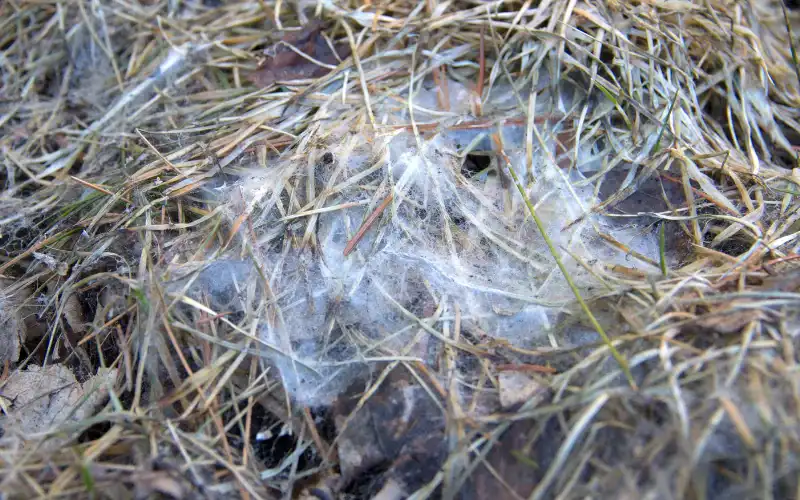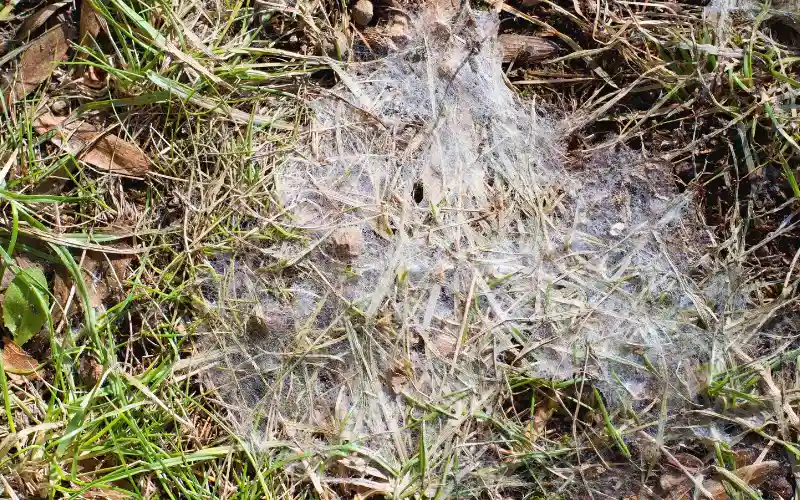Image by Tunatura from Getty Images on Canva
Ever come back to your lawn after a long winter, only to find it looking a little…funky? Those weird, matted-down patches of discolored grass aren’t just a sign that your yard needs a good mowing–they’re probably snow mold. It’s a common fungal disease that damages lawns when they’re covered in snow, but don’t panic just yet!
Even with proper lawn care, you might experience this issue once in a while. It’s a real bummer, but the good news is it’s not a death sentence for your grass. This guide is here to help you identify what it is, understand why it happens, and most importantly, equip you with the knowledge to prevent and treat it effectively.
What Is Snow Mold?
Snow mold is a type of fungal disease that targets lawns during winter. It thrives under the snow cover, lying dormant in the soil until the right conditions trigger its growth. As the snow melts in late winter or early spring, you might notice unsightly patches of matted or discolored grass, often circular in shape. These patches are the visible signs of damage.
There are two main types of snow mold: gray mold and pink mold. Gray mold is more common and tends to cause less severe damage, while pink mold can be more destructive. Both types share similar causes and prevention methods, but understanding the distinction can help you choose the most effective treatment.
How to Treat Snow Mold
If your lawn has already fallen victim to snow mold, don’t worry – there are effective ways to treat and nurse it back to health. While unsightly, this mold rarely kills the grass outright. The fungus weakens the grass plants, making them more susceptible to other stresses and diseases. However, with proper care and attention, your lawn can recover and regain its vitality.
Gentle Raking
As soon as the snow melts and the ground is firm enough to walk on, gently rake the affected areas. Use a light touch to avoid damaging the grass further. Raking helps break up the matted clumps caused by the winter fungus, allowing air circulation and sunlight to reach the crown of the grass plant, which encourages recovery.
Let Nature Take Its Course
In many cases, especially with gray mold, the grass will often recover on its own as temperatures rise and the sun’s warmth dries out the lawn. The affected areas may appear brown and thin at first, but with time and proper care, the grass should begin to green up again. Be patient and give your lawn a chance to bounce back naturally.
Overseeding (if needed)
If the mold damage is extensive or if bare patches persist after a few weeks, consider overseeding those areas with a suitable grass variety. Overseeding helps fill in the gaps, thickens the lawn, and promotes a healthier, more resilient turf. Choose a grass variety that is well-suited to your climate and soil conditions.
Fungicide (in severe cases)
If the problem persists despite raking and overseeding, or if you’re dealing with pink snow mold, which can be more destructive, a fungicide application might be necessary. Consult a lawn care professional for advice on the appropriate product and timing for application. Fungicides work best when used preventatively, but they can also help in severe cases.
How to Prevent Snow Mold

The saying “an ounce of prevention is worth a pound of cure” couldn’t be more accurate when it comes to snow mold. By taking proactive steps, you will significantly reduce the risk of this pesky fungus invading your lawn and save yourself the hassle of dealing with damage later on.
1. Fall Lawn Care
A healthy lawn is naturally more resistant to diseases. Before winter sets in, make sure your lawn is in top shape. This involves regular mowing to keep the grass short (around 2-2.5 inches), removing fallen leaves and debris that can trap moisture, and aerating the soil to improve drainage.
2. Avoid Late Fall Fertilization
Resist the urge to fertilize your lawn late in the fall, especially with nitrogen-rich fertilizers. While nitrogen promotes lush growth during the active growing season, it can also fuel mold growth if applied too close to winter.
3. Choose the Right Grass Variety
If you live in an area prone to mold, consider choosing grass varieties that are known for their resistance. Some varieties of Kentucky bluegrass and fine fescues are generally more resistant to mold than others.
4. Fungicide Application (if needed)
In regions with harsh winters and a history of severe snow mold outbreaks, applying a preventative fungicide in late fall can offer additional protection. Consult with a lawn care professional to determine the right product and timing for your specific conditions.
5. Snow Management
While it may seem counterintuitive, managing snow on your lawn can help prevent this mold. Avoid creating large piles of snow that take a long time to melt, as this can create ideal conditions for the fungus. Additionally, try to minimize foot traffic on snow-covered lawns to avoid compacting the snow and creating favorable conditions for fungal growth.
Frequently Asked Questions
Should I remove the snow from my lawn in winter?
It’s not necessary to completely remove snow, but avoid piling it up in large heaps on the lawn. This can prolong the melting process and create a more favorable environment for mold.
Will my grass grow back after snow mold damage?
In most cases, yes. Grass usually recovers from mild to moderate mold damage. However, severe cases might require overseeding to fill in bare patches.
When should I apply fungicide for snow mold?
Preventive fungicide applications are typically done in late fall, before the first snowfall. However, timing usually vary depending on your location and specific conditions. It’s best to consult a certified lawn care professional for tailored advice.
Conclusion
So, there you have it – the lowdown on snow mold and how to tackle it head-on. Don’t let this winter fungus ruin your lawn dreams. With a little planning and the right care, you can keep your yard looking its best all year round. Remember, it’s always easier to prevent a problem than to fix it, so start prepping your lawn for winter now and save yourself the headache later. And if mold does strike, don’t worry! Just take a deep breath and keep the tips we’ve shared in mind. Trust us, your lawn will be back to its green and glorious self in no time.
If you need a hand getting your lawn in tip-top shape, you can trust Audet Enterprises. To learn more about how we can help you or schedule an inspection, contact us today!


